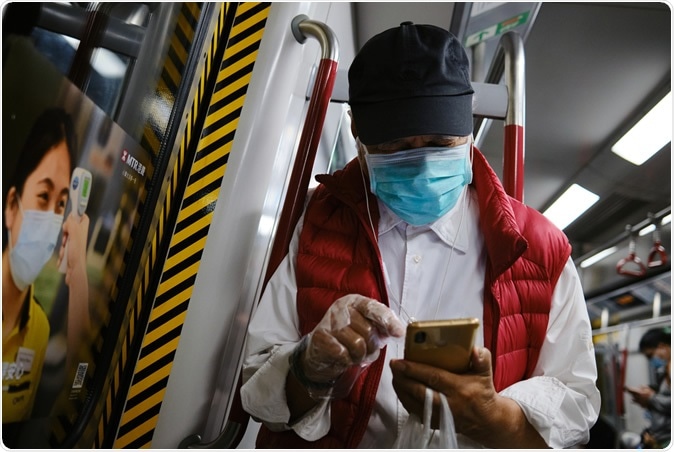Amid the coronavirus disease (COVID-19) pandemic, many countries across the globe have imposed lockdowns in an attempt to reduce the spread of the virus. Still, some countries have not opted for lockdowns, and community quarantines, and still are doing well. Hong Kong, for one, appears to have averted a major COVID-19 outbreak despite not imposing lockdown.

Hong Kong/ China- March 18, 2020: Passengers on a MTR underground metro train wear face masks and gloves as a precautionary measure against the COVID-19 coronavirus. Image Credit: Isaac C.P. Wong / Shutterstock
Governments in Europe and the United States may learn from Hong Kong, which has kept cases and deaths at bay without resorting to lockdowns, which can negatively impact the economy. A new report shows how the country appears to have managed the pandemic with fewer stringent measures.
Hong Kong has a population of nearly 7.5 million, and as of April 21, it has reported 1,026 confirmed cases of SARS-CoV-2 (severe acute respiratory syndrome coronavirus 2) infection, with four deaths. Total cases included 94 asymptomatic carriers. The country gained worldwide praise as it has controlled the virus spread early on in the pandemic.
Now, a new study published in The Lancet Public Health sheds light on how Hong Kong managed to control the spread of the coronavirus through public health measures, without restrictions that are currently taking place in other countries.
Public health measures
What did Hong Kong do to have few infections and deaths, compared to China? The country has imposed a range of public health measures to suppress the local transmission if COVID-19, including behavioral changes.
The country had implemented a rigorous program testing everyone with symptoms of COVID-19. Those who tested positive with the virus were quarantined at a health facility, and all their contacts were traced and advised to self-isolate. By March, health officials in Hong Kong were testing about 400 outpatients and 600 inpatients daily.
Other measures implemented included travel restrictions and bans, school closures from kindergarten to post-graduate studies, flexible working schemes, and cancellations of local mass gatherings. Aside from close contacts, those who arrived from other countries were also isolated and quarantined. Though there are policies imposed, there is no total lockdown in the nation.
These public health measures performed to suppress local transmission in Hong Kong can be adopted by other countries across the globe. Those nations with sufficient resources for mass testing and isolation can roll out these health measures to prevent the rapid spread of the virus, potentially reducing the burden on the health system.
"By quickly implementing public health measures, Hong Kong has demonstrated that COVID-19 transmission can be effectively contained without resorting to the highly disruptive complete lockdown adopted by China, the USA, and Western European countries," Professor Benjamin Cowling from the University of Hong Kong, lead researcher, said.
"Other governments can learn from the success of Hong Kong. If these measures and population responses can be sustained, while avoiding fatigue among the general population, they could substantially lessen the impact of a local COVID-19 epidemic," he added.
Intensive surveillance
In the study, the researchers studied data on laboratory-confirmed COVID-19 cases in Hong Kong between late January and March 31. This way, they can estimate the daily effective reproductive number (Rt) for the coronavirus infection, and changes in transmissibility over time. The team also examined whether the health and control measures implemented have been tied to the diminished silent transmission of the virus.
Included in the health measures is the intensive surveillance for infections. The government has imposed testing and assessment not only for incoming travelers but also in the local community.
Further, Hong Kong imposed social distancing measures in the community, including closing schools, canceling events, and flexible working schemes. Aside from these, the researchers also took into consideration the changes in the behavior of the residents. The team found that individual behaviors in the population have changed in response to the COVID-19 pandemic. About 85 percent of the respondents reported avoiding crowded places, while 99 percent said they are wearing face masks when they leave their homes.
The team found that influenza transmission has also decreased markedly after implementing physical distancing measures and behavioral changes, with a 44 percent reduction in the influenza transmission in late February.
"The speed of decline in influenza activity in 2020 was quicker than in previous years when only school closures were implemented, suggesting that other social distancing measures and avoidance behaviors have had a substantial additional impact on influenza transmission," Dr. Peng Wu from The University of Hong Kong, study co-author said.
"As both influenza and COVID-19 are directly transmissible respiratory pathogens with similar viral shedding dynamics, it's likely that these control measures have also reduced COVID-19 transmission in the community," she added.
Since the 2002 to 2003 outbreak of severe acute respiratory syndrome (SARS), Hong Kong should be prepared and equipped to combat another outbreak. Now, its health measures, such as improving testing and hospital capacities, have helped curb the rapid spread of the virus.
Source:
Source:
Journal reference:
- Cowling, B., Ali, S.T., Ng, T., Tsang, T., Li, J., Fong, M.W., Liao, Q., Kwan, M., and Lee, S.L. (2020). Impact assessment of non-pharmaceutical interventions against coronavirus disease 2019 and influenza in Hong Kong: an observational study. The Lancet Public Health. https://www.thelancet.com/pdfs/journals/lanpub/PIIS2468-2667(20)30090-6.pdf